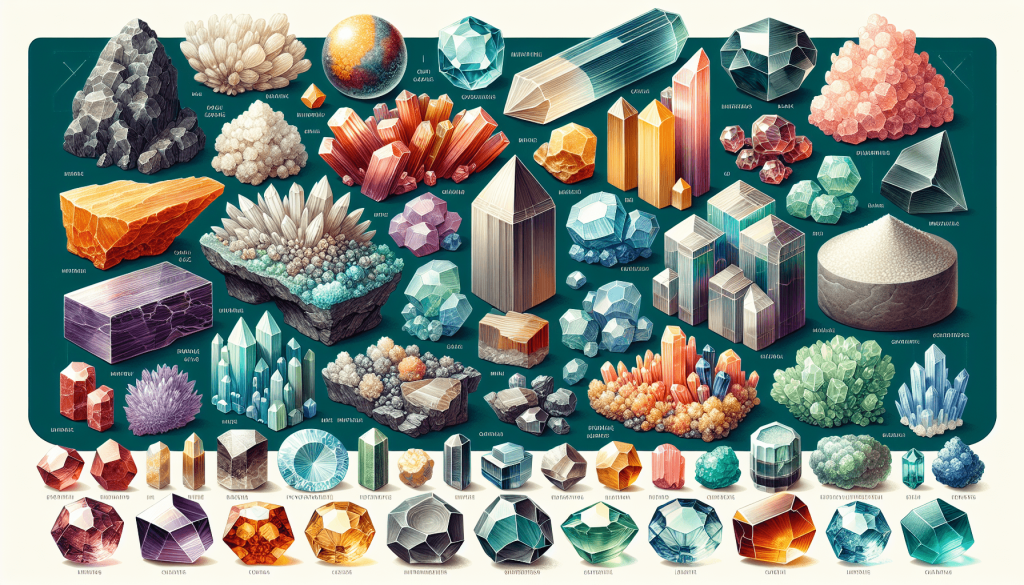Comparing The Chemical Properties Of Different Types Of Minerals
In this article, you will gain a better understanding of the chemical properties of various minerals. By comparing these properties, you will discover fascinating insights into how different minerals interact with their surrounding environments. From the vibrant colors of gemstones to the hardness of quartz, exploring the chemical makeup of minerals will unveil the remarkable diversity and complexity of our natural world. So, get ready to embark on a journey into the intriguing realm of mineral chemistry.
Mineral Composition
Minerals are naturally occurring substances that are composed of various elements and compounds. The composition of a mineral refers to the specific types and proportions of these elements and compounds that make up the mineral. Understanding the mineral composition is essential for identifying and categorizing minerals.
Elements
Many minerals are composed of one or more elements. Elements are the building blocks of minerals and cannot be further broken down into simpler substances. Some common elements found in minerals include oxygen, silicon, aluminum, iron, and calcium. The presence and abundance of certain elements can provide valuable clues about the formation and properties of a mineral.
Compounds
In addition to elements, minerals can also be made up of compounds. Compounds are formed when two or more elements combine chemically. For example, quartz is a mineral composed of the compound silicon dioxide (SiO2). Other common compounds found in minerals include carbonates, sulfides, and oxides. The types of compounds present in a mineral contribute to its physical and chemical properties.
Chemical Structure
The chemical structure of a mineral refers to the arrangement of atoms and molecules within its crystal lattice. The crystal lattice is a repeating pattern of atoms or ions that gives a mineral its characteristic shape and structure. Understanding the chemical structure is important for determining various properties of minerals, such as their bonding, crystal structure, and stability.
Crystal Structure
The crystal structure of a mineral refers to the specific arrangement of atoms or ions within its crystal lattice. Different minerals can have different crystal structures, which are classified into various systems, such as cubic, tetragonal, and orthorhombic. The crystal structure of a mineral can greatly influence its physical properties, including its hardness, shape, and cleavage.
Bonding
The bonding between atoms or ions in a mineral plays a crucial role in determining its properties. Common types of bonding in minerals include ionic, covalent, and metallic bonding. In ionic bonding, electrons are transferred between atoms, creating positively and negatively charged ions that are held together by electrostatic forces. Covalent bonding involves the sharing of electrons between atoms, creating strong bonds. Metallic bonding occurs when free-moving electrons hold positively charged metal ions together. The type of bonding in a mineral affects its hardness, conductivity, and other properties.

Color and Luster
The color and luster of a mineral are observable characteristics that can provide valuable information about its chemistry and composition.
Optical Absorption
The color of a mineral is determined by its ability to selectively absorb certain wavelengths of light. When light interacts with a mineral, some colors are absorbed while others are reflected, giving the mineral its perceived color. The specific elements or compounds present in a mineral can influence its optical absorption properties. For example, the presence of iron can give minerals a red or brown color, while the presence of chromium can result in green-colored minerals.
Reflectance
The luster of a mineral refers to the way it reflects light. Minerals can have various types of luster, including metallic, vitreous (glassy), pearly, or dull. The reflectance of a mineral is influenced by its composition and crystal structure. Metallic minerals exhibit a bright and reflective luster, while vitreous minerals have a shiny, glass-like appearance.
Transparency
Transparency refers to the extent to which light can pass through a mineral. Minerals can be transparent, translucent, or opaque. Transparent minerals allow light to pass through, while translucent minerals transmit light but cause objects to appear blurred or hazy. Opaque minerals do not allow any light to pass through. The optical properties of a mineral are determined by its crystal structure, chemical composition, and the presence of impurities.
Hardness
The hardness of a mineral is a measure of its resistance to scratching or abrasion. It is an important property used for mineral identification and classification.
Mohs Scale
The Mohs scale is a commonly used scale to determine the hardness of minerals. Developed by Friedrich Mohs in 1812, the scale consists of ten reference minerals, each assigned a value from 1 (softest) to 10 (hardest). For example, talc has a hardness of 1, while diamond is the hardest mineral with a hardness of 10. By comparing the hardness of an unknown mineral to the reference minerals, its hardness can be determined.
Scratch Test
The scratch test is a practical way to determine the hardness of a mineral. By observing the scratch resistance of a mineral against a known reference material, such as a fingernail, a copper penny, or a steel knife blade, its relative hardness can be estimated. If a mineral can scratch the reference material, it is harder; if it can be scratched by the reference material, it is softer.

Cleavage and Fracture
Cleavage and fracture are properties related to how minerals break when subjected to external forces.
Cleavage
Cleavage refers to the tendency of a mineral to break along planes of weakness. Minerals with good cleavage break smoothly and cleanly along flat surfaces. The cleavage planes are determined by the crystal structure of the mineral. Depending on the direction and number of cleavage planes, minerals can exhibit different types of cleavage, such as basal, cubic, or prismatic cleavage.
Fracture
In contrast to cleavage, fracture describes the way a mineral breaks when it does not follow a cleavage plane. Minerals that lack cleavage break irregularly and exhibit fracture. Fracture can be conchoidal (smooth and curved), splintery, fibrous, or uneven, depending on the mineral’s composition and structure.
Density
The density of a mineral refers to its mass per unit volume. It is an important property that can be used to distinguish between different minerals with similar appearances.
Specific Gravity
Specific gravity is a measure of the relative density of a mineral compared to the density of water. It is calculated by dividing the density of the mineral by the density of water. Specific gravity is a useful property for identifying and classifying minerals because it remains constant regardless of the size of the sample. Minerals with a specific gravity greater than 1 are denser than water, while minerals with a specific gravity less than 1 are less dense.
Streak
The streak of a mineral refers to the color of the powdered mineral when it is scraped across a rough surface. It is an important property used for mineral identification.
Color of the Powdered Mineral
The streak color is often different from the color of the mineral itself. By rubbing the mineral against a rough surface, such as a streak plate or unglazed porcelain tile, a mineral’s streak color can be observed. The streak color is determined by the presence of trace elements or impurities in the mineral. For example, a mineral with a red streak color may contain iron oxide, even if its external color is different.
Magnetism
Some minerals exhibit magnetic properties, meaning they can be attracted to a magnet or can be magnetized themselves.
Magnetic Properties
Minerals that are magnetic, such as magnetite, contain iron or other magnetic elements. These minerals can be attracted to a magnet and may even become magnetized when exposed to a magnetic field. The magnetic properties of minerals can vary depending on their composition, crystal structure, and the presence of magnetic elements.
Acid Reaction
The acid reaction of a mineral refers to its ability to react with acids. This property is often used in mineral identification.
Ability to React with Acids
Certain minerals can undergo a chemical reaction when they come into contact with acids, such as hydrochloric acid (HCl). This reaction can produce effervescence, where bubbles of gas are released. The specific acid reaction can provide clues about the minerals present. For example, calcite will effervesce and release carbon dioxide gas when it reacts with acid, indicating the presence of calcium carbonate.
Fluorescence
Fluorescence refers to the ability of certain minerals to emit visible light when exposed to ultraviolet (UV) radiation. This property can be used for identification and can create stunning visual effects.
Ability to Emit Visible Light under UV
When exposed to UV radiation, some minerals can absorb the energy and re-emit it as visible light. This phenomenon is known as fluorescence. Minerals such as fluorite, calcite, and willemite are known for their fluorescence properties. The emitted light can have different colors, ranging from blue and green to pink and orange. Fluorescence can be a useful tool in mineral identification and can also be a striking feature in gemstones and minerals used for decorative purposes.
In conclusion, comparing the chemical properties of different types of minerals allows us to understand the diversity and uniqueness of these natural substances. From elements and compounds to crystal structures and bonding, each aspect contributes to the overall characteristics and behavior of minerals. By exploring properties such as color, hardness, cleavage, density, and more, we can unravel the fascinating world of minerals and appreciate their beauty and significance.







